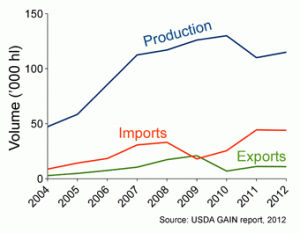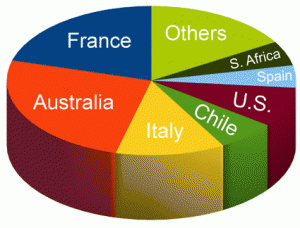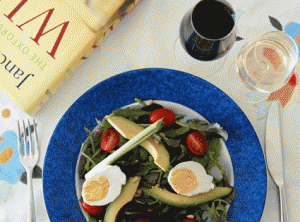There is still a majority view in the UK that the most suitable alcoholic drink to accompany Indian Food is beer. Lord Bilimoria dabbled with selling wines to partner Indian food, but he was not much more successful with this than with his efforts at importing polo sticks. Yet as the founder of Cobra Beer, he created a business whose products are seen and drunk in curry houses from Land’s End to John O’Groats.
This may be about to change, albeit slowly. As Brits increasingly consume more wine at the expense of beer, they are experimenting with food/wine combinations as never before. The old adage that “wine doesn’t match with spicy food” is on its way to the waste bin, aided by imaginative food and wine journalists and competitions such as What Food What Wine.
A number of the more expensive Indian restaurants in London carry extensive collections of wines, sourced from across the globe – see, for example, the Red Fort Wine List. Walk into any Italian restaurant in London and there is bound to be an extensive range of Italian wines on offer. In the same way, do Indian restaurants in London help to promote Indian wines?
In an attempt to anwer this question, I’ve tried to analyse the wine lists of five of the more pre-eminent Indian restaurants in London. Their selection is somewhat arbitary, but probably representative of the sector. The analysis looked at the origins of table wines available by the bottle (sparkling wines almost all hail from a particular part of France, that you may be able to guess!).
The situation for white wines is shown below. In all cases the single largest source of wines is from France, with the rest of Europe in second place. Wines from India occupy a tiny part of the listings, or none at all in the case of two of the restaurants.
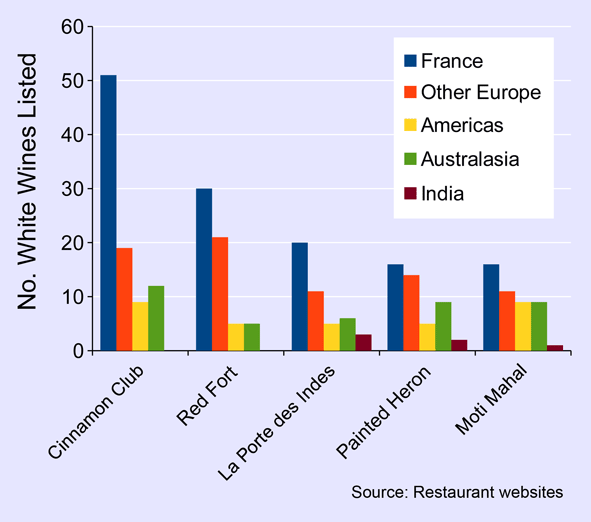
The situation for red wines is little different. Most of the listings are given over to France and the rest of Europe, with Indian wines receiving a coverage which is little more than tokenism.
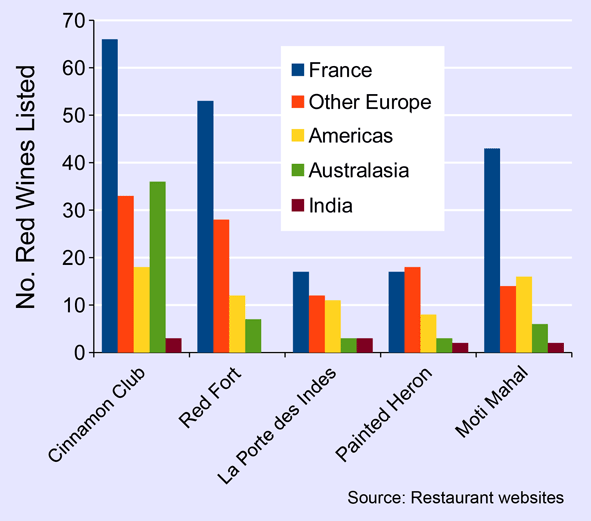
Considering the esteem with which top sommeliers are held these days, these listing seem tired, unimaginative and very conventional. India produces a number of aromatic white wines which are slightly off-dry and have fresh acidity. These can cut through thick sauces and really enhance food flavours. Hot (chilli) dishes may reject coarse tannins, but can often cope well with fruity reds with a smooth tannic structure.
So to sommeliers at London’s Indian restaurants I say: stop playing safe, encourage your clients to experiment, and list more Indian wines. To start you off here are four wines from four different producers that I’ve tried recently and that you could usefully list: Fratelli Chenin Blanc 2012; Vindiva Reserve Estate Sauvignon Blanc 2012; KRSMA Estates Cabernet Sauvignon 2012; Vallonne Vineyards Merlot Resrve 2011.

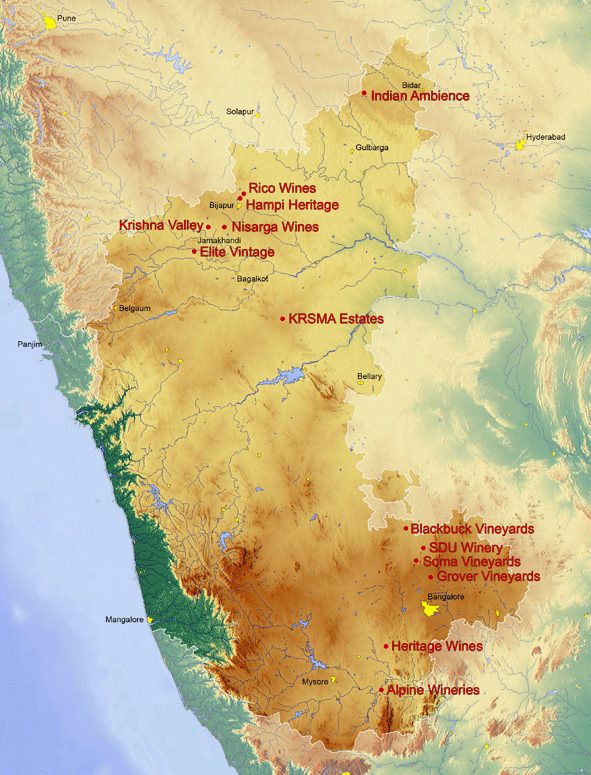
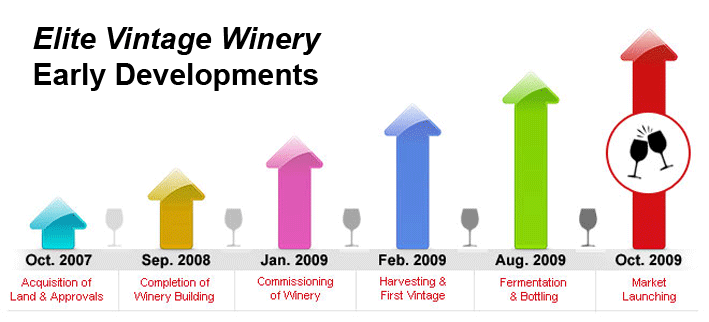 MD Vinod Guraddi and the other members of Elite’s management team have already proven themselves by meeting a series of tough deadlines in order to bring first wine to market in 2009. This was achieved in part by technical assistance from market-leader Sula Wines and it’s good to see different players sharing their knowledge and expertise. Ultimately the free exchange of such information can only be good for the industry as a whole as it seeks to raise standards and improve efficiency.
MD Vinod Guraddi and the other members of Elite’s management team have already proven themselves by meeting a series of tough deadlines in order to bring first wine to market in 2009. This was achieved in part by technical assistance from market-leader Sula Wines and it’s good to see different players sharing their knowledge and expertise. Ultimately the free exchange of such information can only be good for the industry as a whole as it seeks to raise standards and improve efficiency.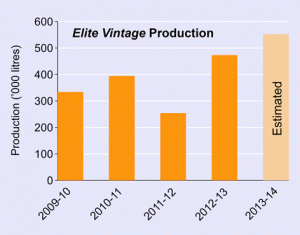 The initial winery capacity of 430 thousand litres was expanded to 730 thousand litres in 2011 and there are plans to add additional capacity next year. This has allowed the winery to ramp up production which it is hoped will break the 0.5 million litres mark in 2013-14.
The initial winery capacity of 430 thousand litres was expanded to 730 thousand litres in 2011 and there are plans to add additional capacity next year. This has allowed the winery to ramp up production which it is hoped will break the 0.5 million litres mark in 2013-14.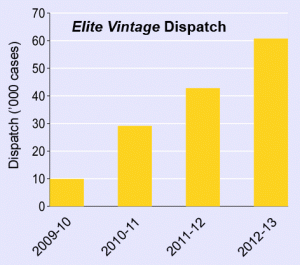 Elite’s wines are currently only available in Karnataka, but their marketing efforts have enabled them to record significant year-on-year increases in dispatch to market. Shipments to the Karnataka market totalled just over 60 thousand cases in 2012-13.
Elite’s wines are currently only available in Karnataka, but their marketing efforts have enabled them to record significant year-on-year increases in dispatch to market. Shipments to the Karnataka market totalled just over 60 thousand cases in 2012-13.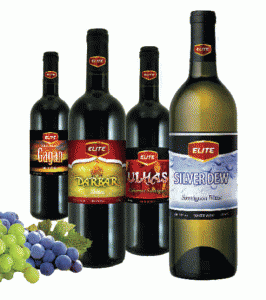 Wines marketed under the Elite label should soon become more widespread as they are already registered to retail in Andhra Praesh and have plans to register in Kerala, Tamil Nadu and Pondicherry. Prices have been fixed at a number of different price points in an attempt to attract a broad range of consumers. Current prices are Rs100, Rs160, Rs280, Rs380 and Rs480.
Wines marketed under the Elite label should soon become more widespread as they are already registered to retail in Andhra Praesh and have plans to register in Kerala, Tamil Nadu and Pondicherry. Prices have been fixed at a number of different price points in an attempt to attract a broad range of consumers. Current prices are Rs100, Rs160, Rs280, Rs380 and Rs480. Elite’s backers appear to recognise that success in the wine business is a long haul process and have confidently drawn up plans for a future winery. An attractive building coupled with visitor facilities would certainly be a welcome addition to the Krishna Valley wine region.
Elite’s backers appear to recognise that success in the wine business is a long haul process and have confidently drawn up plans for a future winery. An attractive building coupled with visitor facilities would certainly be a welcome addition to the Krishna Valley wine region.

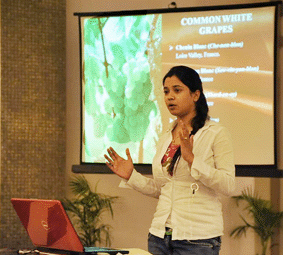
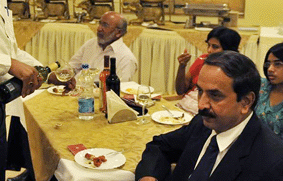 Now the Orange city of Nagpur has joined the trend with the first wine club in central India. The first ever seminar on wine in Nagpur was conducted in late 2010 and following the enthusiasm shown there, the Nagpur Wine Lovers Club (NWLC) was established in Janury 2011 with 11 initial persons. Form these small beginnings, and in less than two years. the NWLC now has 112 registered members. Organised events have seen lectures and tastings from prominent Indian wineries including Sula, Nine Hills, Four Seasons,Turning Point, Chateau D’ori, Ambrosia and Pause.
Now the Orange city of Nagpur has joined the trend with the first wine club in central India. The first ever seminar on wine in Nagpur was conducted in late 2010 and following the enthusiasm shown there, the Nagpur Wine Lovers Club (NWLC) was established in Janury 2011 with 11 initial persons. Form these small beginnings, and in less than two years. the NWLC now has 112 registered members. Organised events have seen lectures and tastings from prominent Indian wineries including Sula, Nine Hills, Four Seasons,Turning Point, Chateau D’ori, Ambrosia and Pause.